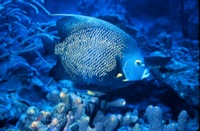
Marine angelfish are perciform fish of the family Pomacanthidae. They are found on shallow reefs in the tropical Atlantic, Indian, and mostly western Pacific oceans. The family contains seven genera and approximately 86 species. They should not be confused with the freshwater angelfish, tropical cichlids of the Amazon River basin.
With their vibrant colours and deep, laterally compressed bodies, marine angelfishes are some of the more conspicuous residents of the reef. They most closely resemble the butterflyfishes, a related family of similarly showy reef fish. Marine angelfish are distinguished from butterflyfish by the presence of strong preopercle spines (part of the gill covers) in the former. This feature also explains the family name Pomacanthidae; from the Greek poma meaning "cover" and akantha meaning "thorn".
Many species of marine angelfishes have streamer-like extensions of the soft dorsal and anal fins. The fish have small mouths, relatively large pectoral fins and rounded to lunate tail fins. The largest species, the gray angelfish, Pomacanthus arcuatus, may reach a length of 60 cm; at the other extreme, members of the genus Centropyge do not exceed 15 cm. A length of 20 to 30 cm is average for the rest of the family. The smaller species are popular amongst aquarists, whereas the largest species are occasionally sought as a food fish; however, there have been reports of ciguatera poisoning as a result of eating marine angelfish.
The larger species are also quite bold and seemingly fearless; they are known to approach divers. While the majority adapt easily to captive life, some are specialist feeders which are difficult to maintain. Feeding habits can be strictly defined through genus, with Genicanthus species feeding on zooplankton and Centropyge preferring filamentous algae. Other species focus on sessile benthic invertebrates; sponges, tunicates, bryozoans, and hydroids are staples.
Most marine angelfishes restrict themselves to the shallows of the reef, seldom venturing deeper than 50 m. The recently described Centropyge abei is known to inhabit depths of 150 m. They are diurnal animals, hiding amongst the nooks and crevices of the reef by night. Some species are solitary in nature and form highly territorial mated pairs; others form harems with a single male dominant over several females. As juveniles, some species may eke out a living as cleaner fish. Common to many species is a dramatic shift in coloration associated with maturity. For example, young male ornate angelfish, Genicanthus bellus, have broad, black bands and are indistinguishable from females; as they mature, bright orange bands develop on the flanks and back. Thought to correspond to social rank, these colour shifts are not necessarily confined to males; all marine angelfish species are known to be protogynous hermaphrodites. This means that if the dominant male of a harem is removed, a female will turn into a functional male. As pelagic spawners, marine angelfishes release many tiny buoyant eggs into the water which then become part of the plankton. The eggs float freely with the currents until hatching, a high number falling victim to planktonic feeders. Queen angelfish, possibly the most beautiful species of angelfish, grows to be 45 cm. With neon blue and yellow scales, with iridescent purple and orange markings, surprisingly it is not conspicuous, and actually hides very well, and is very shy.